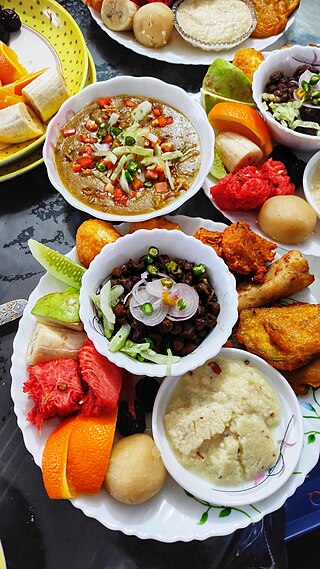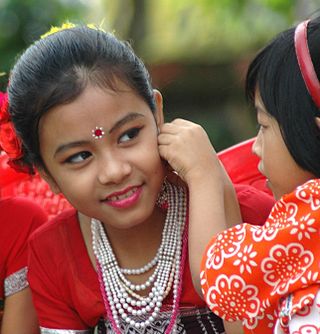
A mikveh or mikvah is a bath used for ritual immersion in Judaism to achieve ritual purity.

In nutrition, diet is the sum of food consumed by a person or other organism. The word diet often implies the use of specific intake of nutrition for health or weight-management reasons. Although humans are omnivores, each culture and each person holds some food preferences or some food taboos. This may be due to personal tastes or ethical reasons. Individual dietary choices may be more or less healthy.

In Judaism, ritual washing, or ablution, takes two main forms. Tevilah (טְבִילָה) is a full body immersion in a mikveh, and netilat yadayim is the washing of the hands with a cup.

The intimate parts of the human body must, according to Islam, be covered by clothing. Most of modern Islamic scholars agree that the 'awrah of a man is the area between the navel and the knees, and the 'awrah of a woman is the entire body except the face, hand; exposing the 'awrah of the body is against Islamic law.

In Islam, fasting is the practice of abstaining, usually from food, drink, sexual activity and anything which substitutes food and drink. During the holy month of Ramadan, sawm is observed between dawn and sunset when the adhan of the Maghrib prayer is sounded. Ramadan is the ninth month of the Muslim lunar calendar and fasting is a requirement for Muslims as it is the fourth of the five pillars of Islam.

The Romanichal are a Romani subgroup within the United Kingdom and other parts of the English-speaking world. Most Romanichal speak Angloromani, a mixed language that blends Romani vocabulary with English syntax. Romanichal residing in England, Scotland, and Wales are part of the Gypsy, Roma, and Traveller community.

The Romani in Spain, generally known by the endonym Calé, or the exonym gitanos, belong to the Iberian Romani subgroup known as Calé, with smaller populations in Portugal and in Southern France. Their sense of identity and cohesion stems from their shared value system, expressed among gitanos as las leyes gitanas.

The Romani people are a distinct ethnic and cultural group of peoples living all across the globe, who share a family of languages and sometimes a traditional nomadic mode of life. Though their exact origins were unclear, recent studies show Kashmir in Northwest India is the most probable point of origin. Their language shares a common origin with, and is similar to, modern-day Gujarati and Rajasthani, borrowing loanwords from languages they encountered as they migrated from India. In Europe, even though their culture has been victimized by other cultures, they have still found a way to maintain their heritage and society. Indian elements in Romani culture are limited, with the exception of the language. Romani culture focuses heavily on family. The Roma traditionally adhere to the belief in Romanipen, within which the concept of Marime plays a key role. The ethnic culture of the Romani people who live in Central and Eastern Europe developed through a long, complex process of continuous active interaction with the culture of their surrounding European population.

There are many cultural aspects surrounding how societies view menstruation. Different cultures view menstruation in different ways. The basis of many conduct norms and communication about menstruation in western industrial societies is the belief that menstruation should remain hidden. By contrast, in some indigenous hunter-gatherer societies, menstrual observances are viewed in a positive light, without any connotation of uncleanness. In most of India, menarche is celebrated as a rite of passage.

The Tripuri culture of North-East India has many distinctive features.
In Jewish religious law, there is a category of specific Jewish purity laws, defining what is ritually impure or pure: ṭum'ah and ṭaharah are the state of being ritually "impure" and "pure", respectively. The Hebrew noun ṭum'ah, meaning "impurity", describes a state of ritual impurity. A person or object which contracts ṭum'ah is said to be ṭamé, and thereby unsuited for certain holy activities and uses until undergoing predefined purification actions that usually include the elapse of a specified time-period.
Pikuach nefesh, which means "saving a soul" or "saving a life," is the principle in Halakha that the preservation of human life overrides virtually any other religious rule of Judaism. In the event that a person is in critical danger, most mitzvot become inapplicable if they would hinder the ability to save oneself or someone else. However, there are certain exceptions; some rules and commandments may not be broken under any circumstances and thus may require an act of self-sacrifice.

Anti-Romani sentiment is a form of bigotry which consists of hostility, prejudice, discrimination, racism and xenophobia which is specifically directed at Romani people. Non-Romani itinerant groups in Europe such as the Yenish, Irish and Highland Travellers are frequently given the name "gypsy" and as a result, they are frequently confused with the Romani people. As a result, sentiments which were originally directed at the Romani people are also directed at other traveler groups and they are frequently referred to as "antigypsy" sentiments.
Krisi or Krisi-Romani is a traditional court for conflict resolution in the culture of Vlax branch of the Romani people. The term derives from the Greek language, "κρίση" (judgment). It is a key institution for enforcing the Romani Code within Romanipen. It developed in the area of present-day Romania, during the times of the slavery, as a judicial institution of the local Romanies, in order to enforce the community cohesion and its internal balance. After the abolition, from the half of the 19th century onwards, many Vlax Romanies emigrated in the rest of the world, bringing with them the krisi as part of their cultural luggage. More or less formal proceedings exist also among other Romani branches. Some non-Vlax Romanies adopted this institution, like the Drzara from Sweden, in contact with the local Kalderash.

Impurity after childbirth is the concept in many cultures and religions that a new mother is in a state of uncleanliness for a period of time after childbirth, requiring ritual purification. Practices vary, but typically there are limits around what she can touch, who she can interact with, where she can go, and what tasks she can do. Some practices related to impurity after childbirth, such as seclusion, overlap with the more general practice of postpartum confinement.
Romani cuisine is the cuisine of the ethnic Romani people. There is no specific "Roma cuisine"; it varies and is culinarily influenced by the respective countries where they have often lived for centuries. Hence, it is influenced by European cuisine even though the Romani people originated from the Indian subcontinent. Their cookery incorporates Indian and South Asian influences, but is also very similar to Hungarian cuisine. The many cultures that the Roma contacted are reflected in their cooking, resulting in many different cuisines. Some of these cultures are Middle European, Germany, Great Britain, and Spain. The cuisine of Muslim Romani people is also influenced by Balkan cuisine and Turkish cuisine. Many Roma do not eat food prepared by a non-Roma.

A menstruation hut is a place of seclusion or isolation used by certain cultures with strong menstrual taboos. The same or a similar structure may be used for childbirth and postpartum confinement, based on beliefs around ritual impurity. These huts are usually built near the family home, have small doors, and are often dilapidated, with poor sanitation and ventilation, and no windows. The Nepali version, the Chhaupadi, is probably the best-known example, but cultural attitudes towards menstruation around the world mean that these huts exist, or existed until recently, in other places as well. The use of menstrual huts continues to be a cause of death, from exposure, dehydration, snake bite, smoke inhalation, and so on. The use of these huts is illegal in some places.

Romani dress is the traditional attire of the Romani people, widely known in English by the exonymic slur Gypsies. Romani traditional clothing is closely connected to the history, culture, and national identity of the Roma people.

Romani people have been recorded in the United Kingdom since at least the early 16th century. There are estimated to be around 225,000 Romani residing in the UK. This includes the Romanichal, Kale, Scottish Lowland Roma and a sizeable population of Roma from Continental Europe, who immigrated into the UK in the late 1990s/early 2000s and after EU expansion in 2004. They are considered part of the Gypsy, Roma and Traveller (GRT) community.
Jews and Romani people have interacted for centuries, particularly since the arrival of Romani people in Europe in the 13th and 14th centuries. Both communities have histories of living in diaspora communities, and both have experienced persecution in Europe since the medieval period. While antisemitism and anti-Romani bigotry manifest differently, there are overlapping prejudices, such as the use of blood libel; the false accusation that Jewish or Romani people kidnap and kill children for ritualistic purposes. The systematic murder of both Jews and Romani people during the Holocaust has strengthened Jewish-Romani relations during the post-WWII era.














